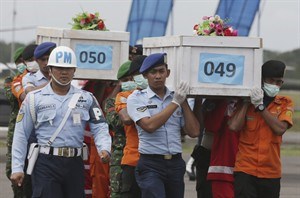
FILE - In this Monday, Jan. 19, 2015, file photo, members of the National Search and Rescue Agency carry coffins containing bodies of the victims aboard AirAsia Flight 8501 to transfer to Surabaya at the airport in Pangkalan Bun. The plane was climbing at an abnormally high rate, then plunged and suddenly disappeared from radar, Indonesia's transport minister said Tuesday, Jan. 20. (AP Photo/Achmad Ibrahim, File)
Republished January 20, 2015 - 12:32 PM
Original Publication Date January 20, 2015 - 6:50 AM
JAKARTA, Indonesia - An AirAsia plane that crashed last month with 162 people on board was climbing at an abnormally high rate, then plunged and suddenly disappeared from radar, Indonesia's transport minister said Tuesday.
Ignasius Jonan told Parliament that radar data showed the Airbus A320 was climbing at about 6,000 feet a minute before it disappeared on Dec. 28.
"It is not normal to climb like that, it's very rare for commercial planes, which normally climb just 1,000 to 2,000 feet per minute," he said. "It can only be done by a fighter jet."
He said the plane then plunged toward the sea and disappeared from radar.
Jonan did not say what caused the plane to climb so rapidly.
In their last contact with air-traffic controllers, the pilots of AirAsia Flight 8501 asked to climb from 32,000 feet to 38,000 feet to avoid threatening clouds, but were denied permission because of heavy air traffic. Four minutes later, the plane disappeared. No distress signal was received.
An excessively rapid ascent is likely to cause an airplane to go into an aerodynamic stall. In 2009, an Air France Airbus A330 disappeared over the Atlantic Ocean in bad weather while flying from Rio de Janeiro to Paris. Investigators were able to determine from the jet's "black boxes" that it began a steep climb and then went into a stall from which the pilots were unable to recover.
Airbus spokesman Justin Dubon said Tuesday that it was too early to comment on possible similarities between the two crashes.
Survey ships have located at least nine big objects, including the AirAsia jet's fuselage and tail, in the Java Sea. The plane's black boxes — the cockpit voice recorder and flight data recorder — have been recovered but are still being analyzed.
"So far, we've managed to download and transcribe half of the cockpit voice recorder," said Nurcahyo Utomo, a commissioner with the National Transportation Safety Committee. "It is too early to draw any conclusion yet because we don't know what is in the remaining half."
He said there was no indication of terrorism, and there were no other voices in the cockpit other than the pilot and co-pilot.
The plane was en route from Surabaya, Indonesia's second-largest city, to Singapore.
Only 53 bodies have been recovered so far. Rough sea conditions have repeatedly prevented divers from reaching the wreckage.
___
Associated Press writers Ali Kotarumalos in Jakarta and Greg Keller in Paris contributed to this report.
News from © The Associated Press, 2015